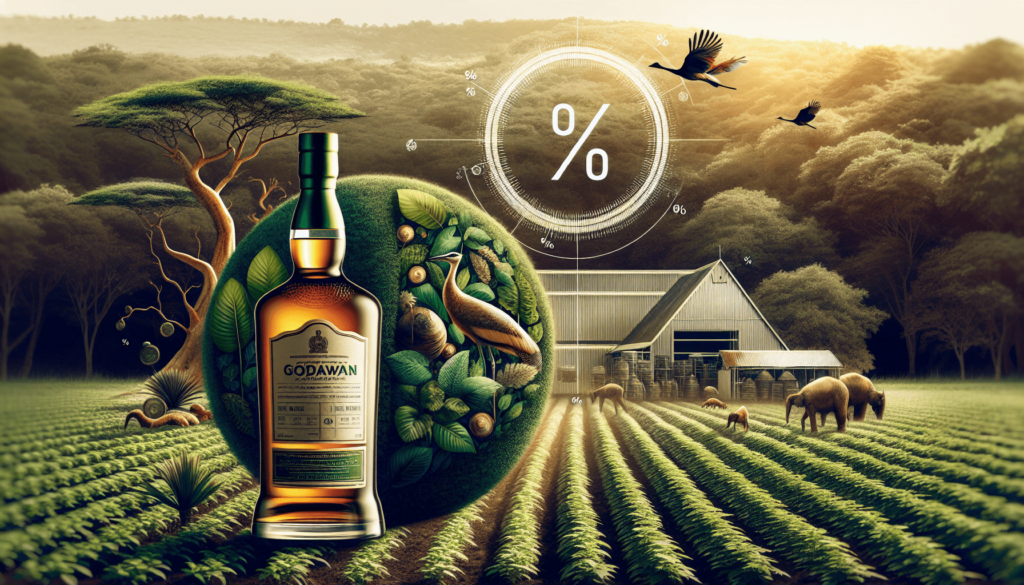Godawan whisky was created as part of corporate conservation efforts for the endangered Great Indian Bustard. Championed by Chaitanya Raj Singh, the king of the Jaisalmer royal family, this whisky not only satisfies the palate but also helps protect the vanishing bird. With only 120 Great Indian Bustards remaining in India, Godawan whisky aims to raise awareness and funds for their conservation.
Distilled in the arid region of Alwar in Rajasthan using locally grown barley and minimal water, this artisanal single malt features an infusion of Indian botanicals that adds flavorful notes of raisin, fig, apricot, and caramel. Singh, along with Diageo, the parent company of Godawan whisky, works closely with the Indian Ministry of the Environment and Wildlife to secure grasslands for the GIB habitat and promote breeding efforts. By enjoying Godawan whisky, individuals are not only indulging in a fine spirit but also contributing to the preservation of a critically endangered bird species.

Table of Contents
Overview of Great Indian Bustard Conservation Efforts
The Great Indian Bustard is an endangered bird species in India that is facing numerous threats to its survival. In this comprehensive article, we will explore the importance of Great Indian Bustard conservation, the current status of the bird, the threats it faces, and the various conservation initiatives and partnerships aimed at protecting it.
Importance of Great Indian Bustard conservation
The Great Indian Bustard plays a crucial role in India’s ecosystem and biodiversity. As one of the bulkiest flying birds in the world, this species serves as an indicator of the health of grasslands. It also helps in seed dispersal and insect control, contributing to the overall balance of the ecosystem. Additionally, the Great Indian Bustard holds cultural and historical significance, having been considered as a contender for India’s national bird.
Current status of the Great Indian Bustard
According to recent estimates, there are only about 120 Great Indian Bustards left in India. The bird’s population has rapidly declined due to factors such as habitat loss, hunting, and collision with power lines. The declining population has led to the species being listed as Critically Endangered on the IUCN red list. Urgent conservation efforts are needed to prevent the extinction of this species.
Threats to the Great Indian Bustard
The Great Indian Bustard faces several threats that contribute to its dwindling population. Habitat loss is one of the biggest challenges, with grasslands being converted into agricultural fields and urban settlements. The bird is also vulnerable to hunting, both for food and sport. Additionally, the Great Indian Bustard is prone to collision with power lines, leading to fatal injuries. These threats, combined with low reproductive rates, make it imperative to address conservation needs.
Conservation initiatives and partnerships
Numerous conservation initiatives and partnerships have been established to protect the Great Indian Bustard and its habitat. One notable example is the collaboration between social entrepreneur Chaitanya Raj Singh and Diageo, the parent company of Godawan whisky. Singh has taken a prominent role in Great Indian Bustard conservation and has worked closely with the Indian Ministry of the Environment and Wildlife to secure grasslands for breeding and conservation purposes.
Introduction to Godawan Whisky
Godawan whisky is a unique alcoholic beverage that has been created as part of corporate conservation efforts for the endangered Great Indian Bustard. Named after the bird itself, Godawan whisky is an artisanal single malt that is distilled in the town of Alwar in Rajasthan, India. It is made using locally grown barley and follows production methods that require minimal water, reflecting the arid region where it is produced. Indian botanicals are also infused into the whisky, adding flavors of raisin, fig, apricot, and caramel.
Description and characteristics of Godawan whisky
Godawan whisky is known for its smooth texture, hint of smoke, and spice. Its distinctive flavor profile makes it a suitable companion for red meat dishes, similar to the way red wine enhances the dining experience. The whisky’s infusion of Indian botanicals adds a unique twist and complexity to its taste. With its connection to the Great Indian Bustard conservation efforts, Godawan whisky has gained recognition as not just a beverage but also a symbol of environmental awareness and sustainable practices.
The link between Godawan whisky and Great Indian Bustard conservation
Godawan whisky is more than just a whisky brand; it is deeply connected to the conservation efforts of the Great Indian Bustard. The creation of this whisky is part of a broader corporate initiative to raise awareness and funds for the bird’s protection. By purchasing and enjoying Godawan whisky, individuals contribute to the conservation projects and partnerships aimed at safeguarding the habitat and population of the Great Indian Bustard. The brand’s commitment to sustainability and environmental responsibility further amplifies its connection to the conservation cause.
Godawan Whisky Pairings
To fully appreciate the unique flavors of Godawan whisky, it is essential to explore suitable pairings that enhance its taste and create a memorable dining experience. One recommended pairing is with red meat dishes, as the whisky’s smooth texture and smoky undertones complement the savory flavors of meats such as mutton and beef. The depth of flavor in Godawan whisky adds another layer of complexity to the dining experience, making it a favorite choice for whisky enthusiasts and food connoisseurs alike.
Chaitanya Raj Singh’s laal maas canapés
Chaitanya Raj Singh, a champion for the Great Indian Bustard conservation cause, has created a signature dish called laal maas canapés to be paired with Godawan whisky. Laal maas, meaning “red meat,” is a traditional mutton curry that originated in the royal kitchens of Rajasthan. Singh’s modern twist on this classic dish involves serving a drier version of the curry on top of Indian flatbread as an appetizer or finger food. The slow-cooked mutton curry, infused with spices and aromatics, is perfectly complemented by the smoothness of Godawan whisky.
Chaitanya Raj Singh’s involvement in Great Indian Bustard conservation
Chaitanya Raj Singh, the 44th titular king of the Jaisalmer royal family, has been actively involved in the conservation efforts for the Great Indian Bustard. Apart from promoting Godawan whisky and its connection to conservation, Singh has played a crucial role in partnering with Diageo and the Indian Ministry of the Environment and Wildlife. His commitment to securing grasslands for the bird’s habitat and raising awareness about the importance of conservation has made him a prominent figure in the field.

Partnership with Diageo for conservation efforts
Godawan whisky’s parent company, Diageo, has been an instrumental partner in the Great Indian Bustard conservation initiatives. Diageo’s collaboration with Chaitanya Raj Singh and other stakeholders has facilitated the implementation of conservation projects and the allocation of necessary resources. The partnership has allowed for a more comprehensive approach to protecting the Great Indian Bustard, leveraging Diageo’s expertise alongside Singh’s passion for conservation.
Godawan Whisky Production
Godawan whisky is produced in the town of Alwar in Rajasthan, India. The production process emphasizes sustainability and minimal water usage, reflecting the arid climate of the region. Locally grown barley is used in the production to support local agriculture and reduce carbon footprint. The distillation methods employed ensure that the whisky maintains its unique flavor profile while minimizing its impact on the environment. The infusion of Indian botanicals adds a distinct character to the whisky, paying homage to the rich cultural and botanical heritage of India.
Use of locally grown barley and minimal water usage
As part of its commitment to sustainable practices, Godawan whisky uses locally grown barley in its production. This not only supports local farmers but also reduces the carbon footprint associated with transportation. Additionally, the production process emphasizes minimal water usage, considering the scarcity of water resources in the arid region where the whisky is distilled. By prioritizing local ingredients and responsible water management, Godawan whisky sets an example for environmentally conscious production practices.
Infusion of Indian botanicals for added flavor
Godawan whisky stands apart from other whiskies with its infusion of Indian botanicals. This unique feature adds layers of flavor and complexity to the whisky, creating a distinctive taste experience. The infusion process incorporates botanicals such as raisin, fig, apricot, and caramel, which are representative of the diverse flavors found in Indian cuisine and culture. The result is a whisky that captures the essence of India, both in its production methods and in its flavor profile.
Collaboration with Indian Ministry of Environment and Wildlife
Given the importance of grasslands as the preferred habitat for the Great Indian Bustard, collaboration with the Indian Ministry of the Environment and Wildlife is crucial for conservation efforts. Godawan whisky, through its partnership with Chaitanya Raj Singh and Diageo, has actively coordinated with the ministry to secure grasslands for breeding and conservation purposes. This collaboration aims to create a more conducive environment for the birds to thrive and increase their population, ultimately ensuring the long-term survival of the Great Indian Bustard.
Importance of grasslands for Great Indian Bustard habitat
Grasslands serve as vital habitats for the Great Indian Bustard, providing suitable breeding grounds and foraging areas. The conservation efforts aimed at protecting this species necessarily involve the preservation and restoration of grassland ecosystems. These grasslands not only support the Great Indian Bustard but also contribute to the overall health of the ecosystem by supporting a diverse range of flora and fauna. Recognizing the critical role of grasslands in the bird’s conservation is crucial for developing effective strategies.
Efforts to secure grasslands for breeding and conservation
The collaboration between Godawan whisky, Chaitanya Raj Singh, Diageo, and the Indian Ministry of the Environment and Wildlife focuses on securing grasslands for breeding and conservation purposes. This involves various initiatives, such as land acquisition and restoration projects, to create protected areas specifically designated for the Great Indian Bustard. By ensuring the availability of suitable habitats, these efforts aim to increase the breeding success and overall population of the bird, preserving this iconic species for future generations.
Hope for the recovery and flourishing of the Great Indian Bustard
Despite the challenges faced by the Great Indian Bustard, there is hope for its recovery and flourishing. Successful conservation stories, such as the recovery of the Royal Bengal Tiger, demonstrate the positive impact of dedicated efforts and effective partnerships. Through continued collaboration, research, and community engagement, it is possible to reverse the decline of the Great Indian Bustard. By supporting the conservation initiatives and raising awareness, individuals can contribute to the long-term recovery and conservation of this critically endangered bird species.
Success Stories in Indian Wildlife Conservation
While the Great Indian Bustard faces significant challenges, there have been successful conservation initiatives in Indian wildlife conservation. One notable example is the recovery of the Royal Bengal Tiger, which was brought back from the brink of extinction through dedicated conservation efforts. The positive outcomes achieved in tiger conservation provide valuable lessons and inspiration for the conservation of other endangered species, including the Great Indian Bustard. These success stories demonstrate the potential for recovery and serve as a reminder of the importance of sustained conservation efforts.
Godawan Whisky and Local Cuisine
Godawan whisky, with its unique flavor profile, is well-suited for pairing with Indian cuisine. The smoky undertones and hints of spice in the whisky complement the rich and diverse flavors found in Indian dishes. One particular pairing highlighted by Chaitanya Raj Singh is the combination of Godawan whisky with his signature laal maas canapés. The slow-cooked mutton curry, with its aromatic spices and savory flavors, perfectly complements the smoothness of the whisky, creating a harmonious blend of tastes that enhances the dining experience.
Chaitanya Raj Singh’s laal maas canapés recipe
As a testament to his passion for the Great Indian Bustard conservation and his culinary expertise, Chaitanya Raj Singh shares his recipe for laal maas canapés. This variation of the classic mutton curry is served on top of Indian flatbread, making it a delightful appetizer or finger food. The slow-cooking process intensifies the flavors, creating a rich and aromatic dish that pairs beautifully with Godawan whisky. By sharing this recipe, Singh encourages others to explore the nuances of Indian cuisine and appreciate the cultural connections between food and conservation.
Future Plans for Great Indian Bustard Conservation
The long-term goals for the recovery of the Great Indian Bustard population include increasing their numbers and ensuring the sustainability of their habitat. Conservation efforts will focus on securing more grasslands, implementing protection measures, and raising awareness. By expanding conservation initiatives across India, it is possible to create a network of protected areas and promote sustainable practices that benefit both the Great Indian Bustard and the surrounding ecosystems. The collaboration between various stakeholders, including Godawan whisky, will continue to play a significant role in these future plans.
Expansion of conservation efforts across India
While the initial conservation efforts for the Great Indian Bustard have taken place in Rajasthan, there is a need to expand these initiatives across India. The bird’s habitat extends beyond Rajasthan, and addressing the threats to its survival requires a comprehensive approach that spans different regions. By collaborating with local communities, governmental agencies, and other stakeholders, it is possible to develop tailored conservation strategies that address the specific challenges faced by the Great Indian Bustard in different areas. This expansion will strengthen the conservation network and increase the chances of successfully protecting this endangered species.
Conclusion
In conclusion, the conservation of the Great Indian Bustard is of utmost importance to protect India’s biodiversity and preserve an iconic species. With the creation of Godawan whisky and the efforts of individuals like Chaitanya Raj Singh, there is a growing awareness and support for the conservation cause. By enjoying Godawan whisky and embracing sustainable practices, individuals can contribute to the protection of this critically endangered bird. It is a call to action to support conservation initiatives that safeguard endangered species and promote environmental responsibility. The link between Godawan whisky and Great Indian Bustard conservation represents a unique partnership between corporate conservation efforts and the preservation of biodiversity, showcasing the potential for combining sustainable practices with social and environmental causes.
Related site : Indian single malts could overtake global single malts
The Formation of Lincolnville: A Free Black Community in St Augustine
